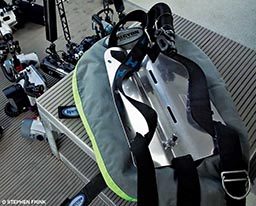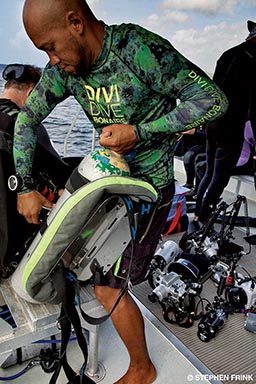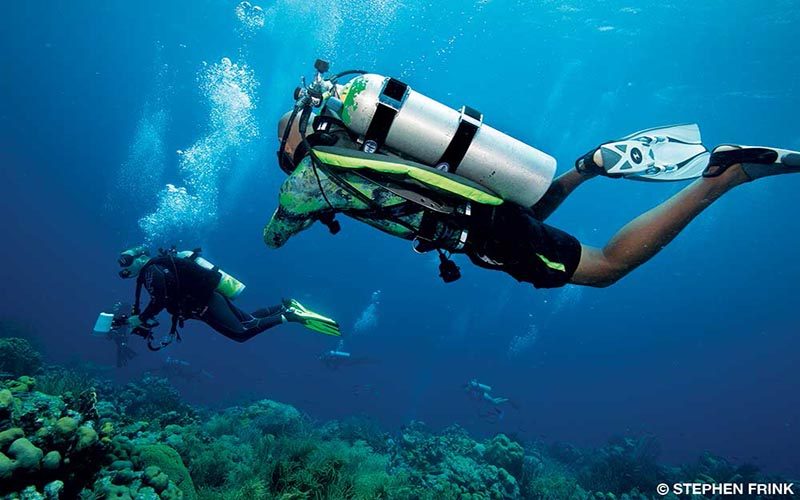Buoyancy compensators (BCs) aren’t terribly complicated — even the most complex ones aren’t much more than balloons we can inflate to counteract negative buoyancy. Despite how the BC has evolved since its inception, it is still fairly similar to the horse collars of yesteryear.
As long as we can reliably remain neutrally buoyant and have a way to safely add and remove enough gas to offset the weight of our equipment and buoyancy changes, we’re set. Aside from these few basic demands, BCs offer a variety of options, which can overwhelm new divers who are selecting their first one. Add to this conundrum the commonly held belief that backplate configurations are exclusively for technical diving.
Gone are the days when backplates were considered complicated or reserved for divers with double cylinders. While technical divers initially developed the configuration, it has become common in recreational diving — and for good reason. The ability to configure a BC to a specific dive or type of diving is incredibly valuable: It can enhance not only your comfort and enjoyment in the water but also your safety. Not all divers prefer backplates, but you should consider all your options before buying your next BC.
What is a Backplate?

Backplate-and-wing BCs are made up of two parts: a sturdy backplate to which a tank can be secured and a wing that can be inflated or deflated to manage buoyancy.
Backplates come in a variety of sizes, designs and materials. Travel backplates made of carbon fiber, titanium and skeletonized aluminum are available, as are more robust, heavier-duty backplates for cold-water diving.
The most common and cost-effective type is a steel or aluminum backplate. Somewhere between just a few pounds to 10 pounds negative, these backplates come with slots for webbing, a few holes at the edge for attaching a drysuit inflation bottle, and slots and holes in the center of the plate for securing one or more tanks.

While twinset tanks are typically bolted directly to the plate, divers can use cam buckles to attach single tanks directly to the plate or to a piece of steel called a single tank adapter (STA), which they then bolt to the backplate. Some wings have extra padding to prevent a single tank that is attached directly to a backplate from flopping back and forth during a dive, but an STA can provide tank stability without the help of wing padding. STAs are also useful for adding extra weight to a backplate — they can be made out of thin aluminum to minimize weight or thick steel with lead inserts to add more weight. There are also adapters for rebreather unit attachment, which enable divers to use the same BC for open-circuit or closed-circuit (rebreather) diving.
Divers typically wear backplates with a webbing harness. A single-piece Hogarthian harness is a good choice, but there are dozens of options that include padding, quick-release buckles and various attachment points. The wing is sandwiched between the tank and the backplate.
Wings come in a huge range of colors, materials, designs and sizes (measured in lift rating). You can choose between a horseshoe wing and a donut wing and one or two bladders. Divers have debated the relative merits of those four options for years, but many instructors recommend a single-bladder donut wing for the majority of applications. These wings are held on with either the bolts that attach the STA to the backplate or the cam bands that hold the tank to the backplate.
How Much Lift Do I Need?
The amount of lift needed is a common consideration when first configuring a backplate and wing. You have the option to choose the size of your wing — how much air it can hold and thereby how much water it can displace — so you have to carefully consider how much negative buoyancy you’ll need to offset. Many configurations are available, but most divers choose a wing that provides just enough buoyancy to make them neutrally buoyant at their heaviest. Divers using a wetsuit and a heavy steel tank would need to determine the combined buoyancy of their body, all of their equipment and the gas in their full cylinder. If the lift calculation puts you squarely between two options for similar wings with different lift ratings, choose the larger one — a safety margin is never a bad thing. Determining lift in this way ensures that your wing can provide adequate buoyancy at the surface and throughout the dive but will not slow you down by being unnecessarily cumbersome.
Why Use Backplates?

There are many reasons to dive using a backplate and wing. Some divers use them to keep their twinset diving skills sharp, even when diving singles. Others use them to tailor a BC to their particular dive, choosing a smaller wing to move effortlessly through tropical waters, a larger wing for cold-water diving or a rebreather attachment to spend hours on a wreck.
It is often easier to trim out a diver in a well-configured backplate because the wing can be adjusted up or down, depending on whether a diver is head or foot heavy, and trim weights can be easily attached to cam bands on the fly. It takes a little extra work to properly set up a backplate, but the rewards are significant for those who are willing to put in the effort. Divers who invest time and effort in the exercise commonly have better trim and buoyancy, which can result in improved gas consumption and decreased fatigue or stress in the water, allowing for better control during their dive.
| © Alert Diver — Q4 2018 |